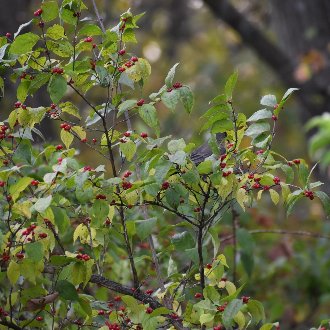Amur Honeysuckle (Lonicera maackii (Rupr.) Herder)
↑Summary
A shrub native to east Asia, and one of the most damaging invasives in the eastern deciduous forests.
↑Range - Expand
| Legend | Color |
| Introduced | |
| Introduced or Not Present |
This tentative map is based on our own research. It may have limited data on Canada and/or Mexico, and there is some subjectivity in our assignment of plants as introduced vs. expanded. Read more in this blog post.
Although this plant occurs somewhere in each of these regions, it may only occur in a small part of some or all of them.
↑Habitat
Found in deciduous woodlands and thickets, especially borders, edges, savannas and other open woodlands, where it often forms large monocultures. Often one of the dominant plants in small woodland fragments in urban, suburban, and industrial areas. Thrives on disturbed sites but also able to invade intact natural areas, especially in bottomlands where the forest canopy is naturally more open.
Usually found in moist to dry-mesic conditions. Prefers nutrient-rich, well-drained loamy to clay-loam soils, but tolerates poor drainage, clay, sandy, rocky, shallow, and compacted soils. Usually limited to soils with pH above 5. Grows both on flat and sloped terrain. Particularly tolerant of soils of patchy fertility, where it benefits from its wide-spreading root system that adapts its form based on the site.
Found in all successional stages of forests, as well as in open, disturbed habitats.
Besides directly planting this shrub, humans have hugely increased its habitat in North America by the creation of edge habitats and fragmentation and degradation of forests.
↑Faunal Associations
In North America, this shrub often attracts white-tailed deer, who favor it because of the dense cover created by its low, arching branches, but only occasionally browse the foliage. The low-arching branches tend to provide easy access for deer ticks to spread to mammals, and in doing so lead to a major increase in the prevalence of Lyme disease in an area.
The flowers attract bumblebees and other long-tongued bees, various moths, and ruby-throated hummingbirds.
The berries are eaten by birds, mostly larger songbirds, but overall, this shrub is damaging to bird populations. Its berries are less nutritious than the diverse array of fruiting plants that it displaces, and it is eaten by fewer insects, thus reducing the availability of insect food for nesting birds. Numerous birds do, however, use this shrub as a nesting site.
There are a small number of generalist insects that occasionally feed on this plant, but it is usually not an important food source for them. Although lepidoptera larvae have been recorded eating this species in its native range, and others eating other members of the Lonicera genus in North America, it is not known whether any lepidoptera feed substantially on this species and it is likely that if they do, it supports lepidoptera much less than native species.
↑Control
Control of this species is labor-intensive but possible. It does not form a long-term seed bank, but it has bird-distributed seeds, so it is important to remove not only all mature individuals from the site itself, but also to remove it from nearby sites from which it can recolonize. With coordination, it can be completely removed from an area in a relatively short amount of time. The three main methods are manual, chemical, and prescribed burns.
Manual control is most effective on sites where plants are small enough to be easily uprooted. Small saplings can easily be uprooted by hand. Larger shrubs can often be removed with the assistance of a tool such as an uprooter or weed wrench. It is often easiest to uproot larger shrubs after rain, when the soil is moist. Some individuals, however, reach a size that is impractical to uproot. These can be cut to the ground, but will typically resprout.
Systemic herbicides can be useful to kill larger individuals. The most effective time to carry out herbicide application is from August to October, as the plant is cycling more nutrients back into the root system; earlier in the growing season, applications are more likely to only top-kill the plant. Herbicide can be applied to leaves, or to stumps immediately after they are cut. The USDA recommends a 2-percent glyphosate solution to treat foliage. For stumps, they recommend a 10% imazapyr solution or 20 percent glyphosate solution. Stump treatment is more effective at reducing damage to non-target plants, but is more labor-intensive as it requires first cutting the plant.
Prescribed burning is not suitable for all sites, but it can be an effective control method on some sites, and it can synergize with other control methods. Fire tends to kill seedlings and unhealthy plants, and it top-kills larger plants. The most effective fires are carried out during the growing season. Usually, larger, healthy plants will resprout after a single fire, and multiple fires, typically annual or biennial burning for 5 years, may be necessary to completely kill plants. Burning can also be combined with other control methods.
Prescribed burning is most effective when there are also other invasives on a site that can be easily controlled by fire, and when the native plants present on the site are well-adapted to fire and benefit from it.
↑Uses
This species was widely planted as a landscaping plant before its invasive potential was recognized.
↑Links & External Resources
• Lonicera maackii (Amur Honeysuckle) | Illinois Wildflowers (About This Site)
• Lonicera maackii (Amur Honeysuckle) | USDA PLANTS Database (About This Site)
• Lonicera maackii | Go Botany (About This Site)
• Lonicera maackii (Amur Honeysuckle) | Missouri Botanical Garden Plant Finder (About This Site)
• Amur Honeysuckle | Virginia Tech Dendrology Factsheets (About This Site)
• Lonicera maackii | Biota of North America Project (BONAP) (About This Site)
• Lonicera maackii | NatureServe Explorer (About This Site)
• Lonicera maackii | Missouri Plants (About This Site)
• Amur Honeysuckle | Maryland Biodiversity Project (About This Site)
• Lonicera maackii (Rupr.) Maximowicz (Amur Honeysuckle) | Digital Atlas of the Virginia Flora (About This Site)





